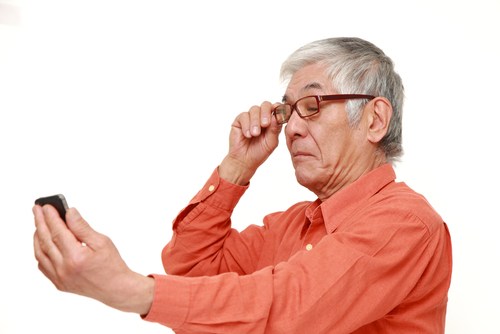
Not too long ago, I joked with my soon-to-be husband, that his eyesight wasn’t what it used to be. Taking a box of cereal or reading a newspaper, he would hold it out as far as his arm would allow and strain his eyes to try and make out the minuscule print. Ah, you’re getting older, I would razz him. First your hearing, and now your eyesight. I thought this was amusing––until it happened to me. As much as we live in denial or the it-will-never-happen-to-me mentality, as we age our vision changes, and it is no laughing matter — we need to know what’s happening and how we can help ourselves.
Dr. Juli Larson, Medical Director at Vermont Eye Laser at New England Vision Correction in South Burlington, says several things happen to our eyes as we age. We first lose the flexibility of our natural lenses, termed presbyopia, which makes reading and close work difficult. This can be corrected with glasses, bifocals (for “near and far” correction) or contacts. Lightweight, with an assortment of frames to make them personal, glasses are a good option for most patients.
Cataracts, a more serious condition where the lens becomes cloudy, can occur at any age, but most commonly in people over age 60. Surgery is required only if the cataract interferes with the vision enough to affect the patient’s lifestyle or if the patient doesn’t see well enough to be considered legally able to drive. Surgery to remove cataracts is very successful, Dr. Larson said, and one of the side benefits can be less dependence on glasses.
Dr. Dora Sudarsky of Chroma Optics in Burlington explained, “Cataracts can cause a gradual loss in vision and increased glare. Sometimes these issues can be addressed by changes in prescription and with tints, but eventually they often need surgery. Dry eyes are another big issue that can be addressed in many ways.”
Dry eye is another big issue that is complicated by screen use, Dr. Sudarsky said. “More and more people are being, diagnosed with it and I am treating it at a much younger age. There are many treatments for dry eyes including drops, vitamin supplementation, lid cleaners and prescription medications. It is best to have a dry eye evaluation to know what is appropriate for your particular type of dry eye.”
Glaucoma is a disease that causes damage to the optic nerve and loss of vision. Unlike cataracts, all vision lost from glaucoma is permanent. Patients are normally not aware of glaucoma-induced eye loss until they have lost significant vision. The only way to diagnose and treat glaucoma is to have routine eye exams in which eye pressure is measured and the optic nerve is examined. Glaucoma can be treated with eye drops, laser treatment and surgery. Dr. Larson recommends a complete eye exam every two years up to age 70, and then annually.
Another prominent vision issue is age-related macular degeneration (AMD). This happens when the area of the retina responsible for our acute, central vision is affected, causing the loss of vision needed to perform tasks such as reading and driving. This can progress over a long period of time or advance rapidly when formation and leaking of abnormal blood vessels occur. Treatment options include ocular vitamins and sometimes injections in the eye. Dr. Larson stressed that macular degeneration does not cause a person to become blind, they still maintain side vision and can maintain independence with the use of visual aids and household modifications.
LASIK (laser-assisted in situ keratomileusis) is the most commonly performed laser surgery to treat nearsightedness, farsightedness and astigmatism (how the eye focuses light). The LASIK procedure reshapes the cornea to enable light entering the eye to be properly focused onto the retina for clearer vision. The actual procedure is done in very little time with results reported within one or two days.
As with all health issues, prevention is key. “The important things to consider with regards to prevention are routine eye exams to diagnose issues early, protection from UV light, an excellent diet and not smoking. Sometimes vitamins are helpful, but should be discussed with your eye care provider,” Dr. Sudarsky said. “If you have decreased vision from one of these diseases, there are glasses that can help.”
It is important to consider that there are options for people that have lost vision and are not helped by regular glasses. This is called low vision. Dr. Sudarsky, Fellow, International Academy of Low Vision Specialists, explained, “In low vision, we prescribe special telescopic and microscopic glasses that allow someone to do specific tasks that they are no longer able to perform without help. A low vision evaluation with a specialist can provide hope and help for these patients.”
Maintaining a healthy, productive lifestyle when vision changes happen sometimes requires modifications to your routine and physical surroundings. Those needing guidance and support to navigate the world after a vision correction or trauma can access the resources of the Vermont Association for the Blind and Visually Impaired. VABVI is a non-profit, private agency offering free training, services and support to visually impaired Vermonters.
Ayesha Raftery wears many hats in her role as Director of Development and Public Education. She stressed the importance of making people aware of what resources are available. Whether it’s in-home training to manage day-to-day tasks, children’s services including working with licensed Teaches of the Visually Impaired or providing technology training and devices to support independence, the mission of VABVI is to assist their clients to achieve and maintain independence.
Many of the people who could benefit from the agency’s services may not know about them––especially those who may not have access to a computer or the Internet and are unaware that help is available. The staff gives talks at clubs, senior centers and events to make as many people as possible aware of VABVI’s services––all free of charge.
Last year, VABVI serviced over 1,100 adults and 284 children from 14 counties in Vermont. Raftery is quick to give credit to volunteers who donated more than 12,000 hours of service in the VABVI’s Transportation Program last year. Volunteer drivers, who are always in demand, travelled more than 117,000 miles last year assisting with grocery shopping, medical appointments and personal trips. Raftery is always looking for volunteers, especially driving volunteers. “It’s very rewarding,” said Raftery. “I feel very passionate about what I do. I love hearing stories about these wonderful people and what they continue to do to be happy. It’s a great feeling.”
Fundraising is a skill Raftery knows well. She, along with her team, are gearing up for the annual Anniversary Gala Dinner and Auction on Thursday, May 26 to be held at the Burlington Country Club, which will include dinner, bidding on handcrafted and local items and being entertained by Jamie Polli, as auctioneer. This year will mark 90 years of providing services to Vermonters with vision challenges. All proceeds will go directly to services for clients––clients including the 272 that are 90 years or older.
The eyes, at any stage of life, are as mysterious as they are beautiful. Knowing there are options and resources when vision becomes less than crystal-clear will help us in our search for answers and empower us to take charge of our health and wellbeing.
 Related Articles & Free Subscription
Related Articles & Free Subscription
Does Medicare Cover Vision Services?
Health Coverage Options for Pre-Medicare-Age Spouses




Comment here